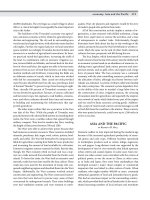Encyclopedia of society and culture in the medieval world (4 volume set) ( facts on file library of world history ) ( PDFDrive ) 823
Bạn đang xem bản rút gọn của tài liệu. Xem và tải ngay bản đầy đủ của tài liệu tại đây (51.39 KB, 1 trang )
796 occupations: The Americas
where a person would serve another person or family within
his or her own community to pay a debt. At least in theory,
once the debt was paid, the person was free. There are examples of former slaves attaining positions of high status in
medieval Africa, including military leaders (in 13th-century
Mali) and political leaders (in the 15th-century Hausa states).
Slaves were often obtained through raids of nomadic or sedentary rural communities or were captives from wars. Slaves
were sold in trading centers and transported long distances
across the continent.
Trade was important during medieval times, and increasingly more people became known as traders, whose
livelihoods were based on transferring goods from one place
to another. Prior to this period much of the trade occurred
through farmers trading directly with herders without the
use of middlemen. Because Berber traders had been crossing
the Sahara long before the medieval period to trade salt and
clothing for gold and ivory with peoples south of the Sahara,
when the trans-Saharan trade networks flourished after the
widespread adoption of the camel for desert travel around
300 c.e., the Berbers were employed to lead the large caravans through the desert. These caravans could include 1,000
to 10,000 camels. In southern Africa trade networks also developed via the eastern coast and the Indian Ocean, and trading occurred directly with Europeans after the Portuguese
established a sea trade route in the 15th century. Increased
trade marked the medieval period in Africa and allowed for
increases in wealth, population, interactions between groups,
and specialized occupations.
The Americas
by
Penelope Ojeda de Huala
By 700 c.e. maize farming dominated the North and South
American continents. This crop allowed for the development of semipermanent and permanent settlements, which
in turn allowed for the development of more specialized jobs
and occupations. The transition from foraging economies to
farming cultures was not uniform in North America. In the
southwest maize made its appearance as early as 300 b.c.e.,
but it was not substantially cultivated until 600 c.e. with the
establishment of small permanent and semipermanent settlements devoted to agriculture and pottery making.
Around 700 to 900 the major traditions of the Hohokam,
Mogollon, and Anasazi established agricultural centers. The
Hohokam culture of northern Arizona is distinguished by
the presence of Mesoamerican features such as ball courts,
platform mounds, and sophisticated irrigation systems. The
Hohokam depended on farming but also produced fine ceramics and stonework, probably employing specialized art-
ists. The settlements of the Mogollon of Arizona, New Mexico,
and Chihuahua, Mexico, strongly resemble those of the Hohokam. They also feature fine ceramics and stonework. The
Mogollon depended on crops as well as hunting and foraging.
The Anasazi of Colorado, Utah, New Mexico, and Arizona
(the ancestors of the modern-day Pueblo of Arizona and New
Mexico) were the most highly developed culture of the Southwest; their stone and adobe buildings were communal complexes built around a central ritual room called a kiva. Some
of the later structures are multistoried, indicating both increased populations and a more complicated social organization, including specialized laborers. Artisans were employed
to create a variety of ritual objects, including ceramics, baskets, textiles, objects made of animals skins, and works made
of a variety of materials, including stone, bone, metal, shell,
feather, and wood.
In eastern North America the Mississippian cultures
adopted full-scale maize agriculture around 800. Squash was
farmed as early as 200 c.e. Maize agriculture accompanied
the development of stratified societies with fortified ceremonial centers. By 1000 these communities centered on maize
agriculture and were ruled by kin-based chiefdoms, and they
continued to fortify their diet by hunting, fishing, and foraging. Complex chiefdoms developed around the 14th and 15th
centuries, just before European contact. As in other agriculturally based societies, ceramics making was a central occupation in Mississippian cultures. As these societies grew,
they built centralized mounds and platforms for ritual functions, and priests were employed to perform ceremonies. As
in the Southwest, artisans were employed to create a variety
of ritual paraphernalia.
Woodworkers were employed in the heavily forested regions of North America, such as the Northwest Coast, to create homes, sleds, boats, snowshoes, traps, totem poles, and
masks. Throughout North America traders and merchants
held important positions in the long-distance trade of prestige objects.
Mesoamerica during the Classic Period (ca. 300–ca. 950)
was dominated by two cultures, Teotihuacán (ca. 1–ca. 650)
and the Maya (ca. 1000 b.c.e.–1521 c.e.). Teotihuacán, a great
metropolis in central Mexico, was a commercial and political
center during the Classic Period. Although much is unknown
of this great culture, archaeological evidence suggests that it
held great influence throughout Mesoamerica as far as the
important Mayan city-state of Tikal in Guatemala. In Teotihuacán specialized architects and builders were employed to
erect monumental pyramid mounds and large open plazas.
Stucco workers, painters, and sculptors also were employed
to decorate these elaborate pyramids. In these paintings and
sculptures, images of warriors and deities perform ritual









